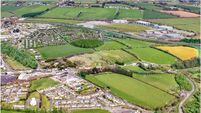Aqua farmers warned as massive algae bloom threatens fish and marine life

.
The algae has already been blamed for de-oxygenating waters off Goleen in West Cork, leading to the destruction of cockles, razor clams and lug worms.
Scientists in the phytoplankton section at the Marine Institute in Galway have been closely monitoring the development and progress of the bloom. Similar blooms caused extensive sea fish kills in 2005 and 2012.
Satellite imagery shows the presence of the bloom, extending 40km-50km offshore south of Valentia Island and all along the south coast in pockets as far east as Dungarvan in Co Waterford.
So far, it has been kept offshore by northerly winds but there is concern a change in wind direction could drive it into coastal waters where it could kill off fish farm stocks.
Fishermen row a boat in Chaohu Lake, China, surrounded by algae as if in a painting pic.twitter.com/q8xrag9MQE
— Kaptan Hindustan™ (@KaptanHindustan) August 31, 2015
Extremely dense concentrations of the microscopic algae species Karenia mikimotoi were identified early last month in samples received by the Marine Institute.
Discoloured brown water patches, caused by the presence of the algae, have been reported by local authorities at some local beaches.
They include Dunmanus Bay and along the south coast at Toormore, near Goleen, and Mizen Head, all in West Cork.
Discoloured water was also reported by fishermen in outer Dunmanus Bay.
The species is harmless to humans and is safe for bathing, However, it can kill fish and other marine organisms by depriving them of oxygen.
For the first time, scientists are supported by the Air Corps to monitor the bloom. The team also sought the help of Goleen Coastguard to monitor the deaths of marine species at inshore areas where some patches of Karenia mikimotoi were discovered.
Marine Institute phytoplankton scientist Joe Silke said they had warned fish farm owners of the potential danger and advised them to acquire equipment which will oxygenate water should the bloom be blown inshore.
The Marine Institute monitors coastal areas year round for blooms because some species can kill wild and farmed fish, while others make shellfish temporarily unsuitable for consumption.
“This joint survey with the Air Corps was an efficient exercise in rapidly gaining large amounts of information regarding the bloom extent, and was the first time that it was used for bloom surveying.
“The Casa CN 235 is particularly suitable because of its range and ability to acquire high resolution photographic imagery,” Mr Silke said.











